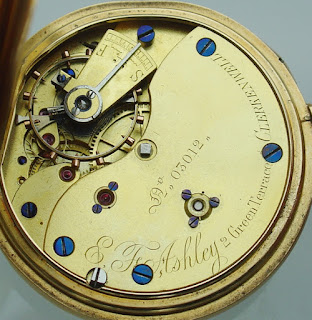.jpg) |
| Fig.1. Isis Medal. Courtesy of Fotolibra |
This was not to be the last of APW’s innovative contributions to the craft of watchmaking. Having been so involved with an aspect of springing with the remontoir, he developed further understanding and expertise with other functionalities founded on the behaviour of a sprung component. The hairsprings then generally available to watchmakers were considerably variable in their quality and performance. As a result, a watchmaker was obliged to use the services of a craftsman specifically skilled in adjusting each individual escapement’s springing to ensure the movement’s good timekeeping. Although this situation provided to APW himself a steady supply of work as such a ‘springer,’ he nevertheless took a bigger-picture view and sought to establish himself as a supplier of springs strictly conforming to physical characteristics which would guarantee consistent performance. To this end he devised a factory process which assured reliable standards of hardening and tempering. According to Gerrit Nijssen, APW established a business to supply the watchmaking trade with these springs at 46 Wilmington Square, in 1858.4
With the advent, mid-century, of an increasing ‘fashion’ for Pocket Chronometers, a need for further improvement in timekeeping accuracy was recognised, and, once more, attention was focused on the hairspring. Since the later eighteenth century the helical form had been in use in Marine Chronometers. This innovation, by John Arnold, was feasible given the size and corresponding space accommodation of these instruments. It was, however, rather bulky for easy incorporation into a pocket-size movement. For such timepieces, isochronous properties were achieved by a Breguet-invented spring form which, while being essentially flat, featured an overcoil/inward twist. At the 1862 International Exhibition a new form, combining the helical and the Breguet solutions was shown by John McLennan of Park Place, Islington. Known as the ‘duo-in-uno’ hairspring, it was hailed as a significant improvement. Its authorship was however disputed. That APW was already aware of the concept was suggested by his ability to introduce several examples into his own presentation at the Exhibition within a day or so. And he contended that the ‘duo-in-uno’ had in fact been invented by Charles Mairet, a Swiss-born Watch Examiner of Crouch Hill. A duo-in-uno spring – from APW’s movement #281 – is shown below:As mentioned above, APW also had premises at Wilmington Square, just to the east of Farringdon Road, Clerkenwell, and close to E. D. Johnson’s premises. He was also at 14 Regent Square, Grays Inn, in the 1850s – T F Cooper owned property here and may well have been APW’s landlord.
Robert Gardner, in his appreciation of APW in the Horological Journal – see footnote 1 – said that APW had told him that he had sprung over 1000 chronometer movements. Nijssen thought that about 500 of these were for other makers/retailers and the remainder under his own signature. Movement number ranges and the allocation of individual numbers are relatively orderly and consistent – unlike many other makers! In the main, there would appear to be two non-consecutive ranges, one using three digits, the lowest I have seen documented being, #182, and the other employing four digits, between ‘#1500’ and ‘#2900.’ Extant examples I have recently noted are shown in the table below, (noting that #4299 would be a number assigned by Parkinson & Bouts, and for a watch sold after APW’s death):
The Horological Journal carried an obituary in its July 1893 issue.6 It contained some high praise for APW, including:
(He), though not much known to the public, had a reputation amongst horologists second to none, and deservedly so. In high-class springing and adjusting his work was as nearly perfect as it is possible for human productions to be. As a manufacturer he was unexcelled.
In his appreciation piece, published in September issue, Robert Gardener claimed in regard to APW’s development of the Pocket Chronometer:
. . . (he) completely transformed the movement, making it a half-plate, and sinking the fourth wheel in the bar.
Thus it would seem that APW not only achieved very high standards of production quality, but also was responsible for a significant development of the model on which other makers executed their Pocket Chronometers. This, together with his specialist springing expertise and success in exporting marks him out as an important figure in chronometer-making in the later nineteenth century.
________________________________________________________________________________
1 As recorded in Robert Gardner’s letter published in the Horological Journal, 36, 01-02 Sept Oct 1893 pp. 4 -6
2 At an even earlier date Cooper was able to include the indication ‘a handsome premium required,’ for example in his advertisement in The Times, 20 August 1819
3 Transactions of the Society of Arts, Vol. 52, (January 1839), pp 75-78; available as a Google eBook
4 Arthur Paul Walsh and Samuel Hammond, by Gerrit Nijssen, NAWCC Bulletin, Volume 38/6, Number 305, December 1996, p. 749
5 He was also briefly in partnership with Robert Oliphant, at 63 Firth Street, Soho in a business supplying tools and materials to the watchmaking trade (dissolved in 1855)
6 Horological Journal, July 1893, p. 48
.jpg)
.jpg)
.jpg)
.jpg)



















